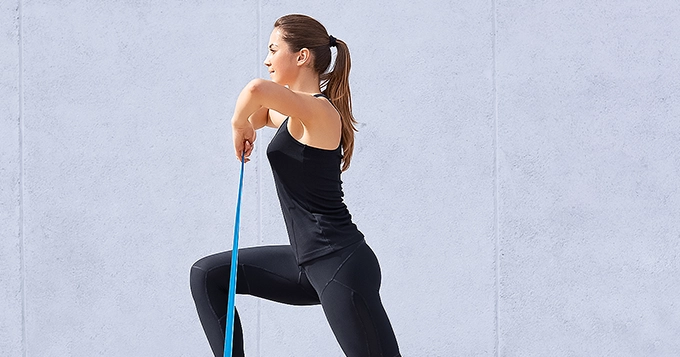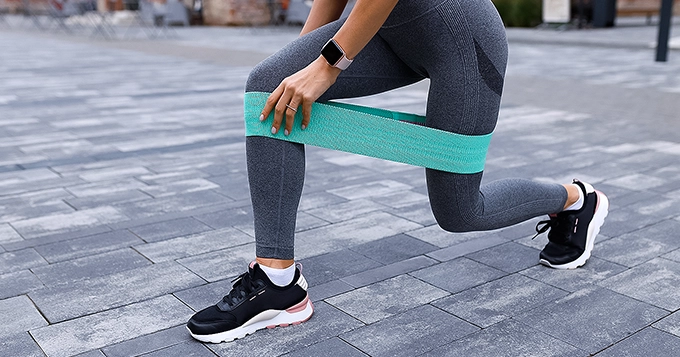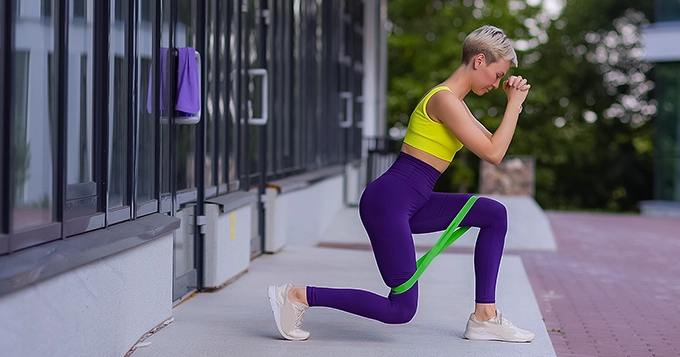What are resistance bands?
Resistance bands, also known as workout bands or exercise bands, are lightweight, inexpensive, and stretchable bands used for resistance training and various forms of exercise. These bands can be used for a wide range of workouts, making them popular among fitness enthusiasts, athletes, and individuals looking for effective home workouts.
Resistance bands are portable, affordable, and can be used for both upper and lower body exercises, making them convenient for home workouts or on-the-go fitness routines. Integrating resistance bands into your training regimen can contribute significantly to strength gains, muscle tone, and overall fitness improvement.
How effective are resistance bands?
Resistance bands are a good tool for rehabilitating a range of injuries. A study in a sports science journal found that using resistance bands is the best way for athletes to get better after hurting their knees. Other research shows that these bands also work well for helping people recover from surgeries and getting back the ability to walk after a stroke.
Resistance bands can be adapted to your fitness level, making them appropriate for a variety of workouts, regardless of experience. They are particularly effective in activating stabilizing muscles, improving joint mobility, and allowing for a full range of motion during workouts.
How to maximize your workout using resistance bands?
Choose The Right Resistance Level
To optimize your resistance bands workout, consider incorporating the best workout bands, as they provide versatile resistance options for enhancing muscle engagement and promoting a well-rounded fitness experience.
How to choose the right resistance bands?
- Know the types of resistance bands.Loop Bands
- Form a closed loop.
- Often used for lower-body exercises like squats and leg lifts.
- Come in various resistance levels.
Tube Bands with Handles:
- Include handles for a better grip.
- Suitable for upper body exercises like bicep curls and shoulder presses.
- Come in various resistance levels.
Flat Bands:
- Long and flat, without handles or loops.
- Versatile for various exercises, including both upper and lower body workouts.
- It can be tied or anchored for different movements.
Figure-8 Bands:
- Resemble the number 8 in shape.
- Provide continuous resistance, ideal for certain upper body exercises.
- Often used for chest presses and lateral raises.
Therapy bands:
- Flat, wide bands made from latex or rubber.
- Commonly used in physical therapy and rehabilitation.
- Color-coded to indicate different resistance levels.
Mini Bands:
- Small, looped bands.
- Focus on activating smaller muscle groups.
- Ideal for hip and glute exercises.
- Consider the strength of the band.
The strength or tension of the band is the most important factor to consider when shopping for a resistance band. As a beginner, you are supposed to begin with a light band and slowly progress to heavier bands.
Bands are often color-coded. Usually, yellow is the lightest resistance band, while black means heavy. But keep in mind that color systems differ between brands and products.
- Prioritize quality.
When making your purchase, you should also search for high-quality bands. A resistance band that becomes sticky or breaks in the middle of a workout is the last thing you want.
Additionally, it’s a good idea to inspect for wear and tear prior to each workout. It’s time to replace it if you see any damage to the band or breaks in the rubber.
- Consider material
Resistance bands are available as an elastic fabric or rubber latex.
Fabric bands are great for lower body exercises because they stay in place and don’t roll up or slide around during your workout. On the other hand, latex bands, being more stretchy, are better suited for upper body workouts, explosive movements, exercises promoting joint stability, and stretching.
Maintain Proper Form
Maintaining proper form during resistance band exercises is crucial for maximizing effectiveness, preventing injuries, and ensuring you target the intended muscle groups. Here are essential tips to help you maintain the correct form:
Proper form in exercise resistance bands is vital for maximizing effectiveness, preventing injuries, and targeting specific muscle groups. It ensures efficient workouts, reduces injury risks by maintaining correct alignment, and contributes to stability and balance. Additionally, proper form supports consistent progress, enables a full range of motion, and establishes a foundation for safe fitness progression.
Gradual Progression
Gradual progression with resistance bands is a key principle for achieving sustained fitness gains.
Start with a resistance level that challenges but allows you to maintain proper form. As your strength improves, gradually increase the resistance to continue pushing your limits.
Gradual progression is essential in fitness for several reasons. Firstly, it allows your muscles, joints, and connective tissues to adapt to increasing demands, reducing the risk of injuries associated with abrupt intensity changes.
Secondly, it provides a sustainable and realistic approach to building strength and endurance over time, fostering long-term adherence to a fitness routine. Gradual progression also enables you to monitor and understand your body’s response to increased challenges, helping you gauge when to push harder or scale back.
Combine with other exercises
By integrating resistance band exercises with traditional or bodyweight movements, you engage multiple muscle groups simultaneously, promoting a comprehensive and balanced fitness regimen.
For example, pairing resistance band squats with bicep curls not only targets your lower body but also engages your arms, offering a full-body workout.
Combining resistance band exercises with other movements not only adds variety to your routine but also maximizes the efficiency of your workout. It enhances overall strength, endurance, and flexibility, providing a diverse and dynamic exercise experience that contributes to a well-rounded and effective fitness program.
Benefits of Resistance Bands
- Versatility
Resistance bands are incredibly versatile, and you can use them for a wide range of exercises targeting different muscle groups. Whether you’re focusing on strength training, flexibility, or rehabilitation, these bands can be adapted to suit your specific fitness goals.
- Portable and Convenient
Easily portable, resistance bands make it convenient to exercise anywhere, be it at home, in the gym, or while traveling. Their compact size allows for effective workouts without the need for bulky equipment.
- Cost-Effective
They offer a budget-friendly alternative for achieving a full-body workout without the need for an extensive set of weights or machines.
- Suitable for All Fitness Levels
It doesn’t matter what your fitness level is. Beginners and advanced individuals alike can use resistance bands. The variety in band resistance levels ensures that you can gradually progress as your strength improves.
- Joint-Friendly
Resistance bands are also gentle on the joints because of their smooth and controlled resistance. This makes them an excellent option for individuals who are recovering from injuries or those with joint issues.
- Enhanced Muscle Engagement
The constant tension provided by resistance bands throughout the range of motion engages muscles effectively. This can lead to improved muscle activation and, consequently, greater strength gains and muscle tone.
- Improved Flexibility
Incorporating resistance bands into stretching exercises can enhance flexibility and joint mobility. The bands allow for controlled stretching, helping to improve the range of motion over time.
- Adaptable to Various Exercises
This equipment can be seamlessly integrated into a variety of exercises, including squats, bicep curls, lunges, shoulder presses, and more. This adaptability adds variety to your workouts, preventing monotony and keeping your routine engaging.
- Stabilization Training
Resistance bands engage stabilizing muscles, contributing to improved balance and core strength. This is particularly beneficial for enhancing overall stability and reducing the risk of injuries.










